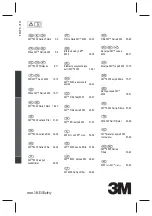
8
SECTION IV. INSTALLATION STEPS
All plumbing should be done in accordance with
state and local plumbing codes.
NOTE
: Some codes may require installation by a
licensed plumber; check with the local plumbing
authority prior to installation.
In restricted under–sink areas, it may be easier to
install the faucet fi rst. Allow ad e quate tubing lengths
for any fi nal component position.
A. Faucet With Water Quality Monitor Installation
–
The faucet contains an anti–siphon air gap.
While the system is producing water, the drain
water fl ows from the R.O., through the air gap
and then to the household drain. The purpose of
the air gap is to prevent water in the drain from
backing up into the R.O. Drinking Water System.
NOTE:
For proper installation the Air Gap Faucet
has a critical level line “CL” marked on its body
and should be mounted so that the “CL” line is at
least one (1) inch (26mm) above the fl ood level
rim of the sink.
The easiest installation is to use an existing
spray attachment hole. If the spray faucet hole is
not available, then the sink top must be drilled.
Choose a convenient location as described in
Sec. III, C.1, page 7.
1. Mark the location of the center of the faucet
base.
2a. Drilling a stainless steel sink:
•Center punch the hole to provide a starting
point for the drill.
•Start with a smaller drill as a pilot, and then
drill a ½" diameter hole to accept the bolt of
a 1¼" Greenlee Hole Punch (1¼" chassis
punch).
•Clean away any chips.
•Install the punch and tighten the nut to cut
the hole.
•Deburr any sharp edges.
2b. Drilling a porcelain sink:
It is best to use a special 1¼" diameter cutter
designed for porcelain. A carbide tipped
masonry bit is a second choice.
•Place a piece of tape over the area to be
drilled to help prevent chip ping.
•Drill a pilot hole for the porcelain cutter.
Use the pilot drill supplied with the kit or a
car bide tipped drill.
•When drilling the 1¼" hole, drill slowly and
carefully; the porcelain chips easily.
•After drilling, clean the area well. Iron fi lings,
if left in place, can cause rust stains.
2c. Drilling a counter top:
NOTE:
The counter top must be less than
1¼" thick. Treat ceramic tile as por ce lain until
the tile is pen e trat ed, then use the carbide
tipped metal cutter.
Formica counter tops may be drilled with a
good 1¼" wood bit; drilling a
3
/
32
" pilot hole
will help keep the bit going straight.
3. Assemble and attach the Faucet, Water
Quality Monitor Faucet Base and tubing (refer
to Fig. 2A & 2B, page 9.)
•Assemble the Body and Spout by removing
the plastic ship ping plug from the Body and
then fi rmly pressing in the Spout.
Locate the ¼" Black Drain Tubing which
is shipped loose in the box. Connect the
Black Drain Tubing to the ¼" Hose Barb on
the Dispensing Faucet by fi rmly pressing
over the barb. Allow the tubing to relax,
then press fi rmly again to insure proper
seating. The end of the Black Drain Tubing
that should be inserted into the "Drain" port
on the R.O. Manifold will have a blue drain
restrictor in it. DO NOT attach this end to
the Dispensing Faucet.
Locate the
3
/
8
" Black Drain Tubing which is
shipped loose in the box. Firmly press one
end of the tubing over the
3
/
8
" drain outlet
hose barb on the Dispensing Faucet. Allow
tubing to relax, then press fi rmly again to
insure proper seating. No connectors are
required when attaching tubing to Hose
Barbs.
Slide Water Quality Monitor Faucet Base
over ¼" Black Drain Tubing,
3
/
8
" Black Drain
Tubing and
7
/
16
" stud screw and seat with
Amber/Green LED's aligned under Air Gap
Window on Dispensing Faucet. (See Figure
2A, page 9.)
Assemble the Plastic Spacer (with open
end upwards and facing tubing), the
7
/
16
"
Washer and the
7
/
16
" Hex Nut onto the
7
/
16
"
stud screw. Do Not tighten at this point.
Summary of Contents for ECLIPSE WRO-35
Page 20: ...20 NOTES...
Page 23: ......









































